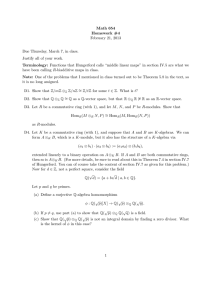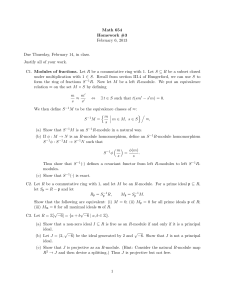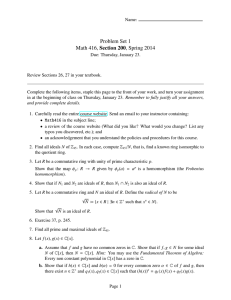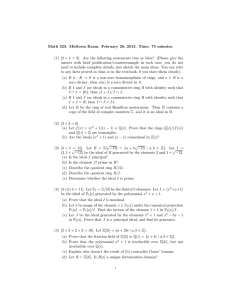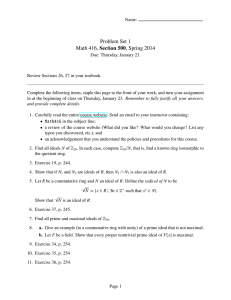Graphs and principal ideals of finite commutative rings Rose- Hulman
advertisement
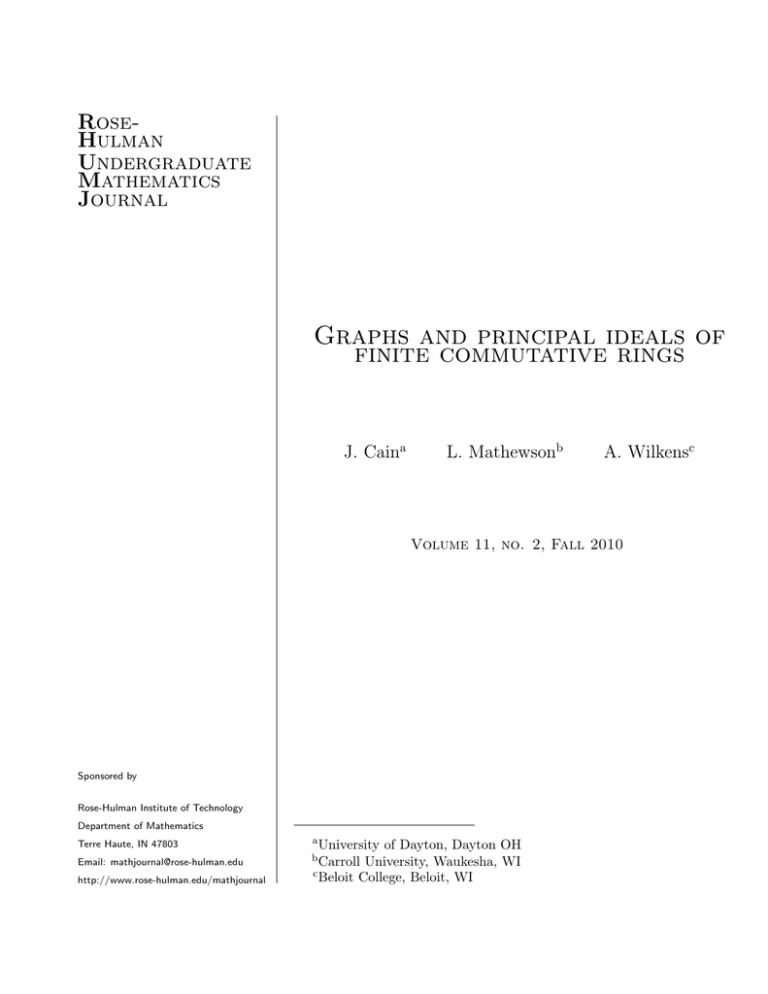
RoseHulman
Undergraduate
Mathematics
Journal
Graphs and principal ideals of
finite commutative rings
J. Caina
L. Mathewsonb
A. Wilkensc
Volume 11, no. 2, Fall 2010
Sponsored by
Rose-Hulman Institute of Technology
Department of Mathematics
Terre Haute, IN 47803
a University
Email: mathjournal@rose-hulman.edu
b Carroll
http://www.rose-hulman.edu/mathjournal
of Dayton, Dayton OH
University, Waukesha, WI
c Beloit College, Beloit, WI
Rose-Hulman Undergraduate Mathematics Journal
Volume 11, no. 2, Fall 2010
Graphs and principal ideals of finite
commutative rings
J. Cain
L. Mathewson
A. Wilkens
Abstract. In [1], Afkhami and Khashyarmanesh introduced the cozero-divisor
graph of a ring, Γ0 (R), which examines relationships between principal ideals. We
continue investigating the algebraic implications of the graph by developing the
reduced cozero-divisor graph, which is a simpler analog.
Acknowledgements: This research was undertaken at the Wabash College Mathematics
REU in Crawfordsville, Indiana. It was funded by the National Science Foundation, grant
number DMS-0755260. The authors would like to thank Dr. Michael Axtell of the University
of St. Thomas, Dr. Joe Stickles of Millikin University, and Wabash College.
Page 96
1
RHIT Undergrad. Math. J., Vol. 11, no. 2
Introduction
Recent research in commutative algebra has concerned developing a graphical interpretation
of the elements of a given ring, and then graph-theoretically analyzing the depiction to
reach algebraic conclusions about the ring. The most well-known of these models is the
zero-divisor ring, Γ(R), first introduced by Anderson and Livingston in [2]. The vertices of
Γ(R) are precisely the nonzero zero-divisors of the ring R, and two vertices are adjacent if
and only if their product is zero. In [1], Afkhami and Khashyarmanesh expanded upon this
notion with the cozero-divisor graph, Γ0 (R), in which the vertices are precisely the nonzero,
non-unit elements of R, denoted W (R)∗ , and two vertices x and y are adjacent if and only
if x 6∈ (y) and y 6∈ (x); in other words, neither x nor y is a multiple of the other in R.
For example, Figure 1 portrays cozero-divisor graph of the ring Z12 . They proved several
results that demonstrated that Γ(R) and Γ0 (R) are related. For example, for a finite ring
R, the vertex sets of the two graphs are equal. (For a discussion on why Γ0 (R) is called the
cozero-divisor graph, see [1].)
In Section 3, we examine some of the results of Afkhami and Khashyarmanesh about Γ0 (R)
and offer additions to some of their theorems. In Section 4, we note that Γ0 (R) is not the
most efficient graph to portray information regarding principal ideals and subset inclusion,
and we introduce the reduced cozero-divisor graph, Γ* (R), as a way to improve efficiency. We
examine the basic graph-theoretic properties of Γ* (R), as well as its relationship to Γ0 (R). In
Section 5, we explore the algebraic implecations of the structure of Γ* (R). In particular, we
examine the ways in which the graph relates to the decomposition of R into a direct product
of fields and local rings.
Figure 1: Γ0 (Z12 )
2
Background
Let R be a commutative ring with identity and R∗ = R \ {0}. Then r ∈ R is a zero-divisor
if there exists z ∈ R∗ such that rz = 0. The set of zero-divisors of R is denoted Z(R), and
the set of nonzero zero-divisors is denoted by Z(R)∗ . An element a of R is said to be a unit
of R if there exists a−1 such that aa−1 = 1R . An ideal of R is a subring I of R such that
if a ∈ I and r ∈ R, then ar ∈ I. An ideal M of R is said to be maximal if for all ideals
RHIT Undergrad. Math. J., Vol. 11, no. 2
Page 97
J 6= M , M ( J implies J = R. If R has a unique maximal ideal M , R is said to be local
and is often denoted (R, M ).
If b ∈ R, the principal ideal generated by b is the ideal (b) = {br|r ∈ R}. In general, an
ideal is said to be principal if it can be generated by an single element of R. The trivial
principal ideals of R are {0} = (0) and R = (1) = (u) for all units u of R.
A graph G is defined as the pair (V (G), E(G)), where V (G) is the set of vertices of G and
E(G) is the set of edges of G. An element of E(G) has the form {a, b} where a, b ∈ V (G)
and a 6= b. If {a, b} ∈ E(G), we say a is adjacent to b, and we write a—b. A graph G is said
to be complete if a—b for all distinct a, b ∈ V (G), and G is said to be empty if E(G) = ∅.
Note by this definition that a graph may be empty even if V (G) 6= ∅. An empty graph
could also be described as totally disconnected. If |V (G)| ≥ 2, a path from a to b is a series
of adjacent vertices a—v1 —v2 —· · · —vn —b. The length of a path is the number of edges it
contains. A cycle is a path that begins and ends at the same vertex in which no edge is
repeated, and all vertices other than the starting and ending vertex are distinct. If a graph
G has a cycle, the girth of G (notated g(G)) is defined as the length of the shortest cycle
of G; otherwise, g(G) = ∞. A graph G is connected if for every pair of distinct vertices
a, b ∈ V (G), there exists a path from a to b. If there is a path from a to b with a, b ∈ V (G),
then the distance from a to b is the length of the shortest path from a to b and is denoted
d(a, b). If there is not a path between a and b, d(a, b) = ∞. If S = {d(a, b)|a, b ∈ V (G)},
then the diameter of G is diam(G) = sup(S). If G1 and G2 are graphs, an isomorphism is
a bijection φ : V (G1 ) → V (G2 ) such that a—b in G1 if and only if φ(a)—φ(b) in G2 . If such
a function exists, we say G1 and G2 are isomorphic. Finally, a graph G is finite if V (G) is
finite.
All images in figures were generated by [6]
Throughout, R will denote a commutative ring with identity.
3
The Cozero-Divisor Graph
[1] is currently the only published literature concerning the cozero-divisor graph of a ring.
Here we will provide several fundamental results, similar to those proved for other graphical
depictions of rings, which have not yet been addressed.
Theorem 2.10 in [1] states that if Z(R) 6= W (R), then Γ0 (R) is finite if and only if R is
finite, where W (R) = W (R)∗ ∪ {0}. We provide a proof for a more generalized statement.
Theorem 3.1. Γ0 (R) is finite if and only if R is finite.
Proof. Suppose Γ0 (R) is finite. Then |W (R)∗ | < ∞ implies that |Z(R)| < ∞; hence, |R| < ∞
by [2, Theorem 2.2]. The other direction is trivial.
The authors of [1] did not investigate direct products of rings, but in fact Γ0 (R) preserves
connectedness over a direct product.
Page 98
RHIT Undergrad. Math. J., Vol. 11, no. 2
Theorem 3.2. Let R ∼
= R1 × R2 × · · · × Rn , where Ri is a commutative ring for all i ∈
{1, 2, . . . , n}. Let x, y ∈ R with x = (x1 , x2 , . . . , xn ) and y = (y1 , y2 , . . . , yn ). If xi —yi in
Γ0 (Ri ) for some i ∈ {1, 2, . . . , n}, then x—y in Γ0 (R).
Proof. Suppose x is not adjacent to y. Then without loss of generality, x ∈ (y). There exists
z ∈ R such that zy = x = (z1 y1 , z2 y2 , . . . , zn yn ) = (x1 , x2 , . . . , xn ). Thus xi = zi yi for all
i ∈ {1, 2, . . . , n}, and hence xi is not adjacent to yi in Γ0 (Ri ) for all i ∈ {1, 2, . . . , n}.
The converse does not hold. If x—y in Γ0 (R1 × R2 × · · · × Rn ), it is possible that xi is
not adjacent to yi for all i ∈ {1, 2, . . . , n}. For example, in Γ0 (Z16 × Z16 ), (2, 4)—(4, 2), but
2 is not adjacent to 4 in Γ0 (Z16 ). In fact, Γ0 (Z16 ) is empty.
Corollary 3.3. Let Ri be a commutative ring for all i ∈ {1, 2, . . . , n}. If a cycle exists in
Γ0 (Ri ) for some i ∈ {1, 2, . . . , n}, then a cycle exists in Γ0 (R), where R ∼
= R1 × R2 × · · · × Rn .
Proof. Suppose ai —bi —· · · —ci —ai is a cycle in Γ0 (Ri ). Then (0, 0, . . . , ai , . . . , 0)—
(0, 0, · · · , bi , . . . , 0)—. . .—(0, 0, . . . , ci , . . . , 0)—(0, 0, . . . , ai , . . . , 0) is a cycle in Γ0 (R).
In [1], Afkhami and Khashyarmanesh introduced Γ0 (R) primarily as a dual to the zerodivisor graph. As such, most of their results concern similarities between the two graphs, as
well as basic graph-theoretic properties of Γ0 (R). Since the graph is built on fundamental
relationships between principal ideals, it seems likely that the structure of Γ0 (R) should
relay nontrivial algebraic information about the ring, so studying it on its own could prove
fruitful. Before we begin this approach, however, we observe that Γ0 (R) is not the most
efficient method of displaying principal ideal relationships in graph form, so we introduce a
more concise analog.
4
The Reduced Cozero-Divisor Graph
It is clear from the definition of the cozero-divisor graph that any two points that generate
the same ideal will play similar roles within the structure of the graph. This next theorem
demonstrates this fact.
Theorem 4.1. Let x, y ∈ W (R)∗ . If (x) = (y), then x is not adjacent to y in Γ0 (R), and
for all z ∈ W (R)∗ , x—z if and only if y—z.
Proof. Suppose (x) = (y). Then (x) ⊆ (y), so x is not adjacent to y. If z is not adjacent
to x, then (z) ⊆ (x) or (x) ⊆ (z). Hence, (z) ⊆ (y) or (y) ⊆ (z), so z is not adjacent to y.
Similarly, if y is not adjacent to z, then x is not adjacent to z.
This tells us that any two points that generate the same ideal will have exactly the same
set of neighbors. In this way, Γ0 (R) is somewhat redundant in its portrayal of relationships
between principal ideals. The inclusion of multiple generators of the same ideal serves only
to complicate the graph as the rings get larger.
RHIT Undergrad. Math. J., Vol. 11, no. 2
Page 99
This fact motivates our definition of a more efficient analog to Γ0 (R): the reduced cozerodivisor graph of R, Γ* (R). The graph is defined as follows. Let Ω(R) designate the set of
principal ideals of R, and let Ω(R)* = Ω(R) \ {(0), R}. (In other words, Ω(R)* is the set
of nontrivial principal ideals of R.) Then V (Γ* (R)) = Ω(R)* , and (a)—(b) if and only if
(a) 6⊆ (b) and (b) 6⊆ (a). Since the point set of Γ* (R) is the principal ideals themselves and
not elements of R, the redundancies of Γ0 (R) are eliminated.
There are significant advantages to studying reduced cozero-divisor graphs as opposed
to the cozero-divisor graphs themselves; first and foremost, as seen in Figure 2, Γ* (R) is
typically a much simpler graph that provides the same information regarding principal ideal
relationships.
Figure 2: Γ0 (Z30 ) and Γ* (Z30 )
Additionally, examining trends in connectedness and cycles becomes much more interesting; for instance, if a, b, c, d ∈ W (R)∗ with (a) = (b) 6= (c) = (d), and (a) 6⊆ (c) and
(c) 6⊆ (a), then a—c—b—d—a is a (rather uninteresting) cycle in Γ0 (R), whereas the only
conclusion we can draw in Γ* (R) is that (a)—(c). As a result, only less trivial cycles and
connections will appear in Γ* (R).
Finally, as will be seen in Section 5, the reduced cozero-divisor graph of an finite commutative ring with identity has a unique relationship to the decomposition of that ring into
local rings and fields that the cozero-divisor graph does not. This shows that Γ* (R) is more
tied to the structure of R than Γ0 (R).
The next few results comment on the relationship between the connectedness of Γ0 (R)
and Γ* (R).
Theorem 4.2. (1) If | Ω(R)* | > 1, then Γ* (R) is connected if and only if Γ0 (R) is connected.
(2) If | Ω(R)* | = 1, then Γ0 (R) is connected if and only if |W (R)∗ | = 1.
Proof. (1) (⇒) Suppose Γ* (R) is connected and let a, b ∈ V (Γ0 (R)) with a 6= b. If (a) 6= (b),
then there is a path from (a) to (b) in Γ* (R) such that (a)—(c1 )—(c2 )— · · · —(cn )—(b).
Thus, a—c1 —c2 — · · · —cn —b is a path in Γ0 (R). If (a) = (b), then choose c ∈ W (R)∗ such
that (a)—(c) in Γ* (R). Then a − c − b in Γ0 (R), so Γ0 (R) is connected.
(⇐) Suppose Γ0 (R) is connected. Then for all a, b ∈ V (Γ0 (R)), a 6= b, there exist
c1 , c2 , . . . , cn such that a—c1 —c2 —· · · —cn —b is a path in Γ0 (R). Thus, (a)—(c1 )—(c2 )—
· · · —(cn )—(b) is a path in Γ* (R), and Γ* (R) is connected.
Page 100
RHIT Undergrad. Math. J., Vol. 11, no. 2
(2) (⇒) Suppose |W (R)∗ | > 1. Since Γ0 (R) is connected, we can choose a, b ∈ W (R)∗
with a 6= b such that a—b. Then for (a), (b) ∈ Ω(R)* , (a) = (b). However, since a—b, a 6∈ (b)
and b 6∈ (a), a contradiction. Therefore, Γ0 (R) is not connected.
(⇐) Trivial.
The following result follows immediately from the definitions.
Proposition 4.3. Γ* (R) is empty if and only if for any (a), (b) ∈ Ω(R)* , (a) ⊆ (b) or
(b) ⊆ (a).
Theorem 4.4. Γ* (R) is empty if and only if Γ0 (R) is empty.
Proof. (⇒) If Γ* (R) is empty, then (x) ⊆ (y) or (y) ⊆ (x) for all (x), (y) ∈ Ω(R)* . Let
x ∈ Γ0 (R). Then (x) ∈ Ω(R)* . If |V (Γ* (R))| = 1, then (ai ) = (aj ) for all ai , aj ∈ W (R)∗ .
So, Γ0 (R) is empty. If |V (Γ* (R))| > 1, then for all (y) ∈ Ω(R)* , (x) ⊆ (y) or (y) ⊆ (x) by
Proposition 4.3. Therefore, for all y ∈ W (R)∗ , y ∈ (x) or x ∈ (y). So, Γ0 (R) is empty.
(⇐) Trivial.
Theorem 4.5. diam(Γ* (R)) ≤ diam(Γ0 (R)).
Proof. Let a0 —a1 —· · · —ak be a path of length k in Γ0 (R). If (ai ) 6= (aj ) for all distinct
i, j ∈ {0, 1, . . . , k}, then (a0 )—(a1 )—· · · —(ak ) is a path of length k in Γ* (R). If (ai ) = (aj )
for some i, j ∈ {0, 1, . . . , k}, then (a0 )—· · · —(ai )—(aj+1 )—· · · —(ak ) is a path of length k
or less in Γ* (R). Thus, diam(Γ* (R)) ≤ diam(Γ0 (R)).
Note that diam(Γ* (R)) is not necessarily equal to diam(Γ0 (R)); as seen in Figure 3,
diam(Γ0 (Z14 )) = 2, whereas diam(Γ* (Z14 )) = 1.
Figure 3: Γ0 (Z14 ) and Γ* (Z14 )
Observe that if Γ* (R) has a cycle, then Γ0 (R) will have a cycle as well (namely, the
generators of the ideals in the cycle of Γ* (R).) However, the converse is not necessarily true.
For example, Γ0 (Z12 ) has a cycle while Γ* (Z12 ) does not (see Figure 4).
RHIT Undergrad. Math. J., Vol. 11, no. 2
Page 101
Figure 4: Γ0 (Z12 ) and Γ* (Z12 )
Theorem 4.6. Suppose Γ0 (R) has a cycle.
(1) If Γ* (R) has a cycle, then g(Γ0 (R)) ≤ g(Γ* (R)).
(2) If Γ* (R) does not have a cycle, then g(Γ0 (R)) = 4.
Proof. (1) If (a1 )—(a2 )—· · · —(an )—(a1 ) is the smallest cycle in Γ* (R), then a1 —a2 —· · · —
an —a1 is a cycle in Γ0 (R). So, g(Γ0 (R)) ≤ g(Γ* (R)).
(2) Suppose a1 —a2 —· · · —an —a1 is a cycle in Γ0 (R). Note that a1 , a2 , . . . , an do not all
generate distinct ideals because then there would be a cycle in Γ* (R). Now suppose there
does not exist i ∈ {1, 2, . . . , n} such that (ai ) = (ai+2 ). Then for some ideal (aj ) = (ak ) with
j < k such that (ai ) 6= (al ) for all distinct i, l ∈ {j, j + 1, j + 2, . . . , k − 1, k} (other than
i = j and l = k), (aj )—(aj+1 )—· · · —(ak ) is a cycle in Γ* (R), a contradiction. Therefore,
there exists an i ∈ {1, 2, . . . , n} such that (ai ) = (ai+2 ). By Theorem 4.1, ai+2 —ai−1 . Hence,
ai−1 —ai —ai+1 —ai+2 —ai−1 is a cycle of length 4 in Γ0 (R), so g(Γ0 (R)) ≤ 4. If there is a
cycle of length 3 in Γ0 (R), say b1 —b2 —b3 —b1 , then clearly, (b1 )—(b2 )—(b3 )—(b1 ) is a cycle
in Γ* (R), a contradiction. Therefore, g(Γ0 (R)) = 4.
Theorem 4.7. If Γ0 (R) has a cycle of odd length, then Γ* (R) has a cycle.
Proof. We will prove this claim by induction as follows: The base case is the statment that
if Γ0 (R) has a cycle of length 3, then Γ* (R) has a cycle, and the inductive hypothesis is the
statement that if Γ0 (R) has a cycle of length n implies that Γ* (R) has a cycle, then Γ0 (R)
having a cycle of length n + 2 should imply that Γ* (R) has a cycle.
If a1 —a2 —a3 —a1 in Γ0 (R), then (a1 )—(a2 )—(a3 )—(a1 ) is a cycle in Γ* (R). Now assume
that if a1 —a2 —· · · —an —a1 is a cycle in Γ0 (R) where n is odd, then Γ* (R) has a cycle.
Consider a cycle a1 —a2 —· · · —an —an+1 —an+2 —a1 in Γ0 (R). If all ai generate distinct ideals
for i ∈ {1, 2, . . . , n}, then (a1 )—(a2 )—· · · —(an )—(an+1 )—(an+2 )—(a1 ) is a cycle in Γ* (R).
Suppose that at least two elements generate the same ideal. If Γ* (R) does not have a cycle,
then by the proof of the previous theorem, there exists k such that (ak ) = (ak+2 ). Since the
cycle is finite, without loss of generality, suppose (an ) = (an+2 ). Then a1 —a2 —· · · —an —a1
is a cycle in Γ0 (R). Thus by our inductive hypothesis, Γ* (R) has a cycle.
5
Γ*(R) and Ring Decomposition
We begin with a generalization of Theorem 3.2 to the reduced cozero-divisor ring, which
states that the adjacencies of the graph of a product of rings depend on those of the component rings.
Page 102
RHIT Undergrad. Math. J., Vol. 11, no. 2
Theorem 5.1. Let R ∼
= R1 × R2 × · · · × Rn , where Ri is a commutative ring for all i ∈
{1, 2, . . . , n}. Let x, y ∈ R with x = (x1 , x2 , . . . , xn ) and y = (y1 , y2 , . . . , yn ). If (xi )—(yi ) in
0
Γ* (Ri ) for some i ∈ {1, 2, . . . , n}, then (x)—(y) in Γ* (R).
Proof. Suppose (x) is not adjacent to (y). Then without loss of generality, x ∈ (y). Then
there exists z ∈ R such that zy = x = (z1 y1 , z2 y2 , . . . , zn yn ) = (x1 , x2 , . . . , xn ). So xi = zi yi
for all i ∈ {1, 2, . . . , n}, and hence, (xi ) is not adjacent to (yi ) for all i.
As in the cozero-divisor graph, the converse does not hold. In Γ* (Z16 × Z16 ), ((2, 4))—
((4, 2)), but (2) is not adjacent to (4) in Γ* (Z16 ).
Before we continue, it is important to note that the 0 and 1 elements may differ from
ring to ring. However, for simplicity’s sake we will continue to notate them as 0 to 1, and
we leave it to the reader to understand from context which elements are being referred to.
All finite rings can be decomposed such that R ∼
= R1 × R2 × · · · × Rn for i ∈ {1, 2, . . . , n}
where each Ri is a local ring or a field [3]. The following theorems give information about
ring and graph isomorphisms when R is decomposed as above.
Lemma 5.2. Let R = F1 × F2 × · · · × Fn , where Fi is a field for all i ∈ {1, 2, . . . , n}, and
S = {(a1 , a2 , . . . , an )|ai ∈ {0, 1}} \ {0R , 1R }. Then Ω(R)* = {(s) : s ∈ S}. In particular,
| Ω(R)* | = 2n − 2.
Proof. Let b = (b1 , b2 , . . . bn ). If b ∈ S, then (b) ∈ Ω(R)* . Now let b ∈ R such that
(b) ∈ Ω(R)* . Now, bi = 0 for at least one i, else (b) = R. Similarly, bi 6= 0 for some i as well.
Now let r ∈ R with r = (r1 , r2 , . . . , rn ) be defined by
1
if bi 6= 0
ri =
0
if bi = 0
Then r ∈ S. Now, rb = b, so b ∈ (r). To show r ∈ (b), define c ∈ R by
−1
bi
if bi 6= 0
ci =
0
if bi = 0
Hence, cb = r, so r ∈ (b). Therefore, (b) = (r), which implies (b) ∈ {(s)|s ∈ S}. Thus,
Ω(R)* = S.
Note that if x, y ∈ S with x 6= y then (x) 6= (y). Hence, there are 2n choices for a generator
consisting of a 0 or 1 in each component. Since ((0, 0, . . . , 0)), ((1, 1, . . . , 1)) 6∈ Ω(R)* ,
| Ω(R)* | = 2n − 2.
Theorem 5.3. Let R1 ∼
= F1 ×F2 ×· · ·×Fn and R2 ∼
= G1 ×G2 ×· · ·×Gm , where Fi and Gj are
fields for all i ∈ {1, . . . , n} and j ∈ {1, . . . , m}. Then n = m if and only if Γ* (R1 ) ∼
= Γ* (R2 ).
Proof. (⇒) Assume that n = m. By Lemma 5.2, V (Γ* (R1 )) = {((a1 , . . . , an ))|ai ∈ {0, 1}} \
{R1 , (0)}, V (Γ* (R2 )) = {((b1 , . . . , bn ))|bi ∈ {0, 1}}\{R2 , (0)}, and |V (Γ* (R1 ))| = |V (Γ* (R2 ))|.
Now define f : V (Γ* (R1 )) → V (Γ* (R2 ) by f (((a1 , . . . , an ))) = ((b1 , . . . , bn )) where
1
if ai 6= 0
bi =
0
if ai = 0
RHIT Undergrad. Math. J., Vol. 11, no. 2
Page 103
This is clearly a well-defined bijection. Let S1 = {(a1 , a2 , . . . , an )|ai ∈ {0, 1}} \ {0R1 , 1R1 } ⊆
R1 , and let S2 = {(b1 , b2 , . . . , bn )|bi ∈ {0, 1}} \ {0R2 , 1R2 } ⊆ R2 , and let x, y ∈ S1 with x 6= y.
Assume (x) is adjacent to (y). Then (x) 6⊆ (y) and (y) 6⊆ (x). Thus, there are some i, j
such that xi = 0 but yi = 1, and yj = 0 but xj = 1. Now f ((x)) = (c) and f ((y)) = (d),
where ci = 0 if xi = 0 and 1 otherwise, and di = 0 if yi = 0 and 1 otherwise. Hence
(c) = f ((x)) 6⊆ (d), and (d) = f ((y)) 6⊆ (c), so f ((x))—f ((y)). Similarly, f ((x))—f ((y))
implies (x)—(y). Therefore, Γ* (R1 ) ∼
= Γ* (R2 ).
*
*
(⇐) Assume Γ (R1 ) ∼
= Γ (R2 ). Then by Lemma 5.2, 2n − 2 = |V (Γ* (R1 ))| = |V (Γ* (R2 ))| =
2m − 2. Therefore, m = n.
An example of this are Z14 and Z15 , both of which can be decomposed into a direct
product of two fields: Z14 ∼
= Z2 × Z7 and Z15 ∼
= Z3 × Z5 .
Figure 5: Γ* (Z14 ) and Γ* (Z15 )
If a ring decomposes into a direct product of fields, we can additionally determine the
diameter of its reduced cozero-divisor graph based on the length of the product.
Theorem 5.4. Let R ∼
= F1 × F2 × · · · × Fn , where Fi is a field for all i ∈ {1, 2, . . . , n}. Then
1
if n = 2
*
diam(Γ (R)) =
2
if n > 2
Proof. If n = 2, then Ω(R)* = {((1, 0)), ((0, 1))}, and ((1, 0))—((0, 1)). So, diam(Γ* (R)) = 1.
If n > 2, then d = ((1, 1, 0, . . . , 0)) is not adjacent to e = ((1, 0, 0, . . . , 0)), so diam(Γ* (R)) >
1. Note that if R = F1 × F2 × . . . × Fn , then (x) ∈ Ω(R)* implies that x has at least one
component equal to zero; additionally, if (x) 6= (y), then there must exist i, j ∈ {1, 2, . . . , n},
i 6= j, such that xi = 0 and yj = 0. If x = (0, 0, . . . , 0, 1, 0, . . . , 0), with a 1 in the jth position
(or y = (0, 0, . . . , 0, 1, 0, . . . , 0), with a 1 in the ith position), then (x)—(y). Otherwise, let
(c) ∈ Ω(R)* be defined by
1
if k = i or k = j
ck =
0
otherwise
Then (x)—(c)—(y), so diam(Γ* (R)) = 2.
Page 104
RHIT Undergrad. Math. J., Vol. 11, no. 2
When we the consider decomposition of a ring into a direct product of local rings, the
results are not as clean. However, we can determine if the graphs are isomorphic in the
specific case when those local rings are of the form Zpa , where p is prime.
Lemma 5.5. Let R ∼
= Zpa1 1 ×Zpa2 2 ×· · ·×Zpann and S = {(c1 , c2 , . . . , cn ) : ci ∈ {0, 1, pi , . . . , pai i −1 }}\
Q
{0, 1}. Then Ω(R)* = {(s)|s ∈ S}. In particular, | Ω(R)* | = [ ni=1 (ai + 1)] − 2.
Proof. Let y ∈ S. Clearly, (y) ∈ Ω(R)* . Let x ∈ R such that (x) ∈ Ω(R)* . Choose
r = (r1 , r2 , . . . , rn ) such that
0
if xi = 0
ri =
ai
gcd(xi , pi )
if xi 6= 0
Clearly, r ∈ S. We want to show that (r) = (x). Since ri |xi , there exists di ∈ Zpai i such
that ri di = xi for each nonzero xi . We now have rd = x, where d = (d1 , d2 , . . . , dn ). Thus,
x ∈ (r). Since ri = gcd(xi , pai i ), there exist mi , ni ∈ Z with xi mi + pαi i ni = ri . Modulo
pai i , this equation reduces to xi mi = ri . Hence, r ∈ (x). Therefore, (x) ∈ {(s)|s ∈ S},
and Ω(R)* = {(s)|s ∈ S}. Note that all elements of the form (c1 , c2 , . . . , cn ) are distinct
and that there
are ai + 1 choices for the ith coordinate. Since we disregard R and (0),
Q
n
| Ω(R)* | = [ i=1 (ai + 1)] − 2.
Theorem 5.6. Let R1 and R2 be rings with R1 ∼
= Zpa1 1 × Zpa2 2 × · · · × Zpann and R2 ∼
=
Zqb1 × Zqb2 × · · · × Zqm
bm , where pi and qi are prime integers and ai , bj > 1 for i ∈ {1, 2, . . . , n}
1
2
and j ∈ {1, 2, . . . , m}. If n = m and a1 , a2 , . . . , an is a permutation of b1 , b2 , . . . , bn , then
Γ* (R1 ) ∼
= Γ* (R2 ).
Proof. Without loss of generality, suppose ai = bi for i ∈ {1, 2, . . . , n}. By Lemma 5.5,
V (Γ* (R1 )) = {((c1 , . . . , cn )) : ci ∈ {0, 1, pi , p2i , . . . , piai −1 }} \ {R1 , (0)} = S1
V (Γ* (R2 )) = {((c1 , . . . , cn )) : ci ∈ {0, 1, qi , qi2 , . . . , qiai −1 }} \ {R2 , (0)} = S2
Let f : V (Γ* (R1 )) → V (Γ* (R2 )) defined by f ((c1 , . . . , cn )) = (z) where (c1 , c2 , . . . , cn ) ∈ S1
by
0
if ci = 0
z=
qiα
if ci = pαi
Note that by Lemma 5.5, f will be onto; furthermore, |V (Γ* (R1 ))| = |V (Γ* (R2 ))|, so f is
one-to-one.
Let S1 = {(c1 , c2 , . . . , cn )|ci ∈ {0, 1, pi , . . . , pai i −1 }}\{0R1 , 1R1 } and S2 = {(c1 , c2 , . . . , cn )|ci ∈
{0, 1, qi , . . . , qiai −1 }} \ {0R2 , 1R2 } and x, y ∈ S1 . Then (x), (y) ∈ Ω(R1 )∗ . If f ((x)) is not adjacent to f ((y)), then without loss of generality, f ((x)) ⊆ f ((y)). There exist m, n ∈ S2 such
that f ((x)) = (m) and f ((y)) = (n). Since (m) ⊆ (n), there does not exist i such that either
ni = 0 and mi 6= 0, or ni = qiα and mi = qiβ with α > β. Consider f −1 (f ((x))) = (x) and
f −1 (f ((y))) = (y). By definition of f , there does not exist i such that yi = 0 and xi 6= 0 or
yi = pαi and xi = pβi with α > β. Therefore, (x) ⊆ (y), and (x) is not adjacent to (y). Thus,
(x)—(y) implies f ((x))—f ((y)). Similarly, if f ((x))—f ((y)), then (x)—(y).
RHIT Undergrad. Math. J., Vol. 11, no. 2
Page 105
Consider Z72 ∼
= Z23 × Z32 and Z200 ∼
= Z23 × Z52 , and observe that Γ* (Z72 ) ∼
= Γ* (Z200 )
(Figure 7).
Figure 7: Γ* (Z72 ) and Γ* (Z200 )
There are many possibilities for future research into this topic. This could include proving
the converse of Theorem 5.6, and investigating more general decompositions as well. Also,
more research could be done on the characterization of graph-theoretic properties that are
realizable as reduced cozero-divisor graphs, such as the cases in which Γ* (R) has a cycle.
Additionally, connections may be able to be made between Γ* (R) and Γ(R), along the lines
of research in [1].
References
[1] Afkhami, M. and Khashyarmanesh, K., The cozero-divisor graph of a commutative ring,
S.E. Asian Bull. Math, to appear.
[2] Anderson, D. F. and Livingston, P., The zero-divisor graph of a commutative ring, J. of
Algebra, 217 (1999), 434-447.
[3] Dummit, David S., and Foote, Richard M., Abstract Algebra, 3rd Ed. (2004), John Wiley
and Sons, Inc.
[4] Harris, John M. et. al. Combinatorics and Graph Theory (2000), Springer-Verlag New
York Inc.
[5] Hungerford, Thomas W. Algebra (1996), Springer-Verlag New York Inc.
[6] MATHEMATICA, Wolfram Software.
[7] Zariski, Oscar and Samuel, Pierre. Commutative Algebra, Volume I (1958), D. Van Nostrand Company, Inc.
